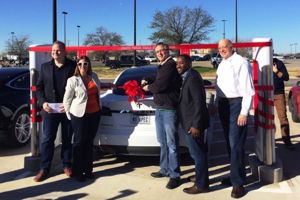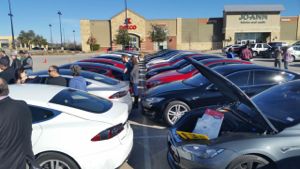
The four-bay Supercharger at 2700 West University Drive can "fill up" a Tesla Model S in 75 minutes. Photos courtesy of the North Texas Tesla Owners Group.
Feb. 7, 2016
By Barbara Kessler
You didn’t hear any engines revving at the latest big auto gathering in Denton. That’s because it was a Tesla event, and Teslas, as even we who don’t drive one know, are silent, awe-inspiring vehicles from the future. They’re mean green machines. It was only natural that about two dozen of them converged on the city of mean green UNT Jan. 30 to inaugurate the first Tesla Supercharger installed in North Texas.
 The four-bay Supercharger at 2700 West University Drive will help connect the dots on a growing network of Tesla chargers set up across North America to enable Tesla owners to charge up in an hour or less. Oh, yes, these are the world’s fastest chargers, designed to serve the world’s most fantastic electric cars and the drivers that shelled out for them.
The four-bay Supercharger at 2700 West University Drive will help connect the dots on a growing network of Tesla chargers set up across North America to enable Tesla owners to charge up in an hour or less. Oh, yes, these are the world’s fastest chargers, designed to serve the world’s most fantastic electric cars and the drivers that shelled out for them.
Tesla owners typically charge their cars overnight at home, which can take about five hours, said Rick Bollar, a Southlake Tesla owner who helped organize the ribbon-cutting event at Denton’s Rayzor Ranch Marketplace.
Tesla fans gathered for the Supercharger ribbon cutting Jan. 30 in Denton. Rick Bollar, Tesla owner, organizer; Lori Clark, principal air planner at the North Central Texas Council of Governments; Denton Mayor Chris Watts; Udeme Umana, Tesla Human Resources; Phil Williams, general manager at Denton Municipal Electric.
When they’re zipping around town, owners don’t really worry much about charging, because Teslas can easily go 220 miles on a single charge.
But when they’re on the road, Tesla drivers don’t want to take hours to “fill up.” The Superchargers make sure they don’t have to. This is huge, says Bollar.
“Typically, when you get home, you plug it (your Tesla) in, it charges all night and you don’t really care how long it takes,” he said. “But when you’re on the road and it only takes 20 minutes that’s transformational for EV owners.”
To get technical for a minute, Tesla reports that it takes just 40 minutes plugged into a Supercharger to fill up the Tesla Model S battery to 80 percent; 75 minutes would fill it to 100 percent.
And these Tesla chargers are not only super quick, they’re free for Tesla owners.
The proprietary system, which is calibrated to service Tesla batteries, is a perk for Tesla enthusiasts, Bollar explained. This means the new SuperChargers aren’t really anything that other electric vehicle (EV) owners can jump up and down about. However, Leaf, Focus and Volt drivers can access some 200 chargers in the Dallas-Fort Worth region and thousands more across the nation for on-the-road charging.
The Tesla Supercharger network, which now has more than 250 stations across North America, is all about the open road, Bollar says. Tesla wants to serve its loyal owners because it knows that once someone owns a Tesla, they’re going to want to take a road trip. And if they take a road trip, they’ll want it to be fun and easy, like driving a Tesla.
Kind of like if you give a mouse a cookie, he’s going to ask you for a glass of milk. Except in this case, it’s a mocha latte and a view of the San Francisco Bay.
 So Denton’s Supercharger is not for locals so much as for the Tesla driver from Houston who needs to top off before heading to Oklahoma, or the Tesla driver from Colorado Springs who’s cruising into town to see the Mavericks.
So Denton’s Supercharger is not for locals so much as for the Tesla driver from Houston who needs to top off before heading to Oklahoma, or the Tesla driver from Colorado Springs who’s cruising into town to see the Mavericks.
Texas being so large, the Denton station will help fill gaps for in-state travel too. It’s the 10th Supercharger station in the Lone Star state and will hold down the north side of the Metroplex while Corsicana offers a charging spot on the south side.
These chargers are typically placed between cities instead of in the heart of them. Thus, there are Supercharger stations in Waco, Huntsville and Columbus, Texas; and on the edge of cities across the U.S.
But as beautiful and futuristic as the Supercharger stations are, the gathering Saturday was not just a celebration of Tesla road travel. Several speakers lauded this latest development in EV infrastructure as another positive step forward for clean energy.
“It’s very important for us that we have those visible reminders in front of the public. It sends the message that we can reduce emissions that cause some of our air pollution problems,” said Lori Clark, principal air planner at the North Central Texas Council of Governments.
Clark says EVs are taking off faster than hybrids did, now that so many automakers offer models in various price ranges.
Speaking of which, Tesla recently announced that it will be unveiling its more affordable Model 3 in March, though auto publications have reported that the “reveal” may be only drawings of the much-awaited Tesla for the masses. The Model 3 has the auto world aquiver because the retail sticker price is supposed to be around $35,000, making it far more affordable than its sister Teslas (which sell for double and triple that) but with similar range of 200 miles per charge, beating all competitors.
Even though gas is cheap right now, such a car – a Tesla for the masses -- would still fire up the EV market, perhaps particularly in DFW.
North Texas, says Clark, leads the state in EV adoption, with about 40 percent of the EVs registered in Texas being located here.
Having those cars on the road is important to reducing ground-level ozone and carbon pollution.
The NCTCOG estimates that each year, EVs in North Texas save tons of air pollution, specifically: 5.19 tons of nitrogen oxides (NOX), 6.84 tons of volatile organic compounds (VOCs) and 8,257 tons of carbon dioxide.
The saved CO2 emissions are equivalent to 50 railcars worth of coal not being burned or 125 tanker trucks of gasoline not being consumed, according to the agency.
Sign up for the weekly Green Source DFW Newsletter to stay up to date on everything green in North Texas, the latest news and events. Follow us on Facebook, Twitter and Pinterest.









